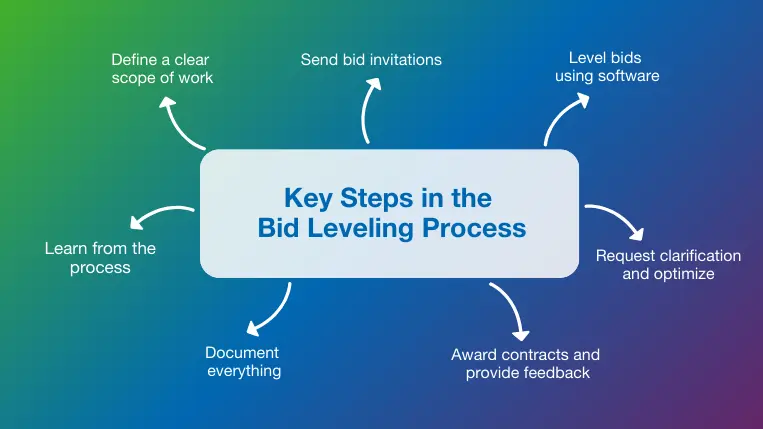11 mins read
Understanding the Nuances and Pitfalls of the Bid Leveling Process

As construction projects become more complex, the process of tendering, receiving, and evaluating bids also gains complexity and importance. Established relationships and gut instinct are still relevant when it comes to awarding contracts, but modern bid management software now makes it easier to streamline bidding and decision-making processes through enhanced data analysis and reporting. Bid leveling is the key to this logical, well-rounded approach. This guide explores the topic in detail!
What Is Bid Leveling?
Bid leveling, also known as bid comparison, is a process that allows clients and contractors to evaluate bids from trade partners on a level playing field. This is accomplished by organizing bids in a way that makes them easier to review and assess unbiasedly.
As construction bid management practices evolved, it became apparent that evaluating bids based on cost alone was a risky practice since it failed to account for factors like experience, reliability, safety, and reputation, which can be equally important when it comes to completing tasks successfully. Unusually low bids might also signal that a bidder does not fully understand the scope of work. Bid leveling software has made it easier to weigh competitive bids quickly and accurately.
What Is the Purpose of Bid Leveling?
Weighing bids can be a time-consuming and inexact process, since it can be hard to decide which combination of factors is most important and who should ultimately be selected for each job. Bid leveling is important for clients and construction project managers, as well as subcontractors seeking out new opportunities, since it enables a logical “apples to apples” comparison while providing the following benefits:
- Identifying gaps: Capturing and comparing bids in a bid leveling sheet helps to make any gaps more obvious, such as missing tasks, pricing discrepancies, or variations in the scope of work. Issues with unit costs or exclusions from the scope of work can also be evaluated more easily.
- Preventing downstream issues: A structured bid leveling process prevents issues during contract completion and beyond by ensuring the scope is properly covered, and the contractor can fully meet their obligations based on the original bid. In this way, bid leveling also becomes a form of construction risk management.
- Improved negotiations: A detailed comparison of bids helps clients and project managers understand the key factors driving costs and how each contractor addresses them. This insight helps them negotiate more favorable contract terms through price reductions or additional services, making bid leveling a great tool for efficient contract management.
Key Steps in the Bid Leveling Process

As the value of bid leveling has been recognized, implementation steps have become more standardized as best practices are shared throughout the industry. Each team will develop its own tools and preferences, but a solid bid leveling strategy should always include a few key steps.
Define a Clear Scope of Work
The first and most important step in bid leveling should be completed long before any bids are tendered. Defining the scope of work (SOW) is essential for defining what resources will be needed to complete the job. The scope should include as much detail as possible so that specific material requirements, timelines, and unique tasks are clearly spelled out.
A detailed SOW also supports the build process by reducing the amount of variation between bids. With expectations clearly stated, there is less interpretation and guesswork involved in the bid creation process. This helps to avoid changes, cost overruns, or rework during the project based on unclear expectations.
Send Bid Invitations
Once the SOW is completed, you can begin sending out bid invitations. These invitations put the information from the SOW, along with compliance requirements, licensing information, and other relevant information into a format contractors can use to complete the bidding process. The invitation should also include a bid closing date that lets them know when they need to submit their proposals.
A bid invitation is also known as a request for proposal (RFP) because it is used to formally request detailed proposals from contractors or suppliers. Bid invitations are another important part of the bid leveling process since they must include all the relevant information in a concise format. Allowing adequate time for responses also improves bid accuracy, since it ensures bidders have ample time to complete their research and calculations.
Level Bids Using Software
Spreadsheets, lists, and bid leveling sheets can help to organize the bid tendering and evaluation processes, but advanced tools like bid leveling software can make the process faster and more equitable. These tools use algorithms to compare bids fairly based on factors beyond cost, like reputation and business stability while making it easier to see the variations and inconsistencies between bids. Software packages can also be used to automate bid leveling along with the reporting that goes with it.
RIB CostX is a versatile takeoff and estimating solution that supports bid leveling with up-to-date, granular cost information and reporting capabilities. Subcontractor comparisons, based on a database of relevant quotes, make it easier to compare bids for specialized work. Subcontractors can also use the convenient RIB CostX viewer tool to submit quotes and view information.
Request Clarifications and Optimize
Bidding is not a one-way street, so part of effective bid leveling is understanding when feedback or adjustments are necessary to make bids more accurate. If anything included in a bid seems unclear or inconsistent with the scope of work, be sure to allow enough time for questions and clarifications so the bids can be updated accordingly.
Bid leveling software can automatically detect these discrepancies and oversights, making it easier to follow up during intensive bidding cycles. Once all bids are corrected, the bidding process is truly optimized, with software tools creating a level playing field, improving decision-making, and streamlining the evaluation process, while eliminating biases that can undermine the process.
Award Contracts and Provide Feedback
Once bids have been leveled and reviewed, the next important step is awarding contracts to the most suitable bidders. Bid leveling builds confidence in this step, along with the data to support each decision. A structured process makes it easier to be transparent both internally and externally when explaining how work was assigned.
Construction analytics software can generate valuable reports for the suppliers selected and those who are not. The clear logic behind the leveling process can be used to inform contractors on where they need to improve to be more competitive with future bids. This transparency helps to build relationships with vendors you are likely to work with again.
Document Everything
Accurate and complete record keeping is another key to effective bid leveling, so you should keep track of all scope changes, bid revisions, project design changes, and notifications that potentially impact contract decisions. A complete set of records allows you to maintain traceability before, during, and after the decision-making process by keeping a history of contributing factors.
Implementing construction document management strategies to record and preserve all information can also maintain compliance with external standards and easily provide the evidence needed to justify contract awards. This unabridged history will also pay dividends in the future, as intelligent bid leveling and cost estimation software tools draw upon historical information to evaluate new bids based on similar tasks.
Learn from the Process
Most importantly, construction bid leveling should be viewed as an opportunity for continuous improvement and learning. As work is completed, the performance of each contractor and supplier can be compared to agreements made during the bidding cycle. The relative weight of each leveling factor should be adjusted continuously based on actual results, so that logical choices are made based on the most current information.
Bid leveling can also help clients and project managers improve the quality of their SOWs and bid invitations as they recognize which formats bring more accurate and timely responses. Over time, the process will allow them to discover how factors other than cost, including those we often overlook, help to identify great suppliers and partners.
Final Thoughts
Bid leveling brings increased fairness, efficiency, and transparency to the bidding process. Bid leveling software takes these benefits to the next level by automating complex information-gathering and analysis steps that lead to optimized decisions. Choosing a winning team to complete your project on time and on budget is a process that can ultimately determine success or failure.
RIB CostX provides the cost estimation, subcontractor comparison, and advanced reporting capabilities required to integrate bid leveling best practices and ensure seamless success. If you are ready to experience our powerful platform, get your free demo of RIB CostX today!

Most Recent
11 mins read
10 mins read
10 mins read
29 mins read
Blog Categories

Ebook











